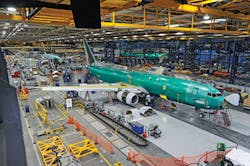IoT and aerospace: implications for improvements within supply chain management
One of the biggest technological advances of today is the capacity for computer-powered devices to connect, gather, and share vast amounts of data with one another. This technology, referred to as the Internet of Things (IoT), allows for the analysis, cross-referencing, and application of collected data faster than ever thought possible. Something as complex as commuter traffic can now be analyzed in real time, with the provision of immediate traffic updates, numerous alternative route suggestions, and redirects for drivers, all parlayed directly through Internet-connected smartphones.
In the aviation industry, IoT has the potential for operational improvements in areas including aircraft performance, air traffic control and maintenance schedules — all of which ultimately lead to greater customer satisfaction. Similarly, for supply chain management, IoT has implications for improving product flow and warehouse efficiency, resulting in improved customer experiences and loyalty.
IoT and the supply chain
During every flight, hundreds of sensors located throughout an aircraft collect large amounts of data. This data gives airlines and manufacturers insight into the performance of nearly every aircraft function (and, in the future, may even include insight into processes outside of aircraft functionality, such as baggage delivery). When the aircraft data is cross-referenced with inventory and supply chain data, the possibilities for maintenance and repair process improvements are tremendous.
A primary function of many of these sensors is to pinpoint areas in need of immediate service, but, taken one step further, the analysis of IoT-collected information could even predict future malfunctions, which may, in turn, trigger an inventory restock alert and limit unscheduled maintenance — a key contributor to flight delays. And just as IoT could lead to improvements in manufacturer and maintenance, repair, and overhaul (MRO) activities, suppliers could use this technology for similar purposes.
The IoT allows for real-time use of the data that these sensors collect, as TechTarget explains. Aviation parts distributors can now track part usage and performance with the intention of ensuring proper stock levels. That means less surplus for distributors and an end to out-of-stock parts for customers. And, even further, by tracking parts while in use, suppliers could have full knowledge of the lifetime of an item, be alerted of a system reaching the end of its lifespan and even have supplies delivered before airlines find themselves in need.
One example of aerospace IoT in action is aircraft parts distributor, Kapco Global’s e-commerce platform Kapco kart. Unlike a typical online shopping cart, which loses usefulness at the end of a transaction, Kapco kart tracks real-time inventory for aviation buyers, including expected arrival times for out-of-stock items. Kart users also have access to viewing in-stock inventory locations, giving aerospace parts buyers’ precise shipping estimates at their fingertips.
As Kapco Global’s Vice President of Information Technology John Valantine explains, “Our focus has always been on providing solutions for our customers. Kapco kart is one solution that utilizes the IoT to provide aviation parts buyers with the information they need to make their aerospace parts ordering fast, simple and efficient. Kart customers have 24/7 access to the aviation industry’s most accurate inventory levels.”
The use of IoT goes beyond better inventory accuracy. In fact, when coupled with lean manufacturing principles, it allows for improvements throughout the entire supply chain.
Lean manufacturing and IoT
Lean manufacturing, derived from the 1930s Toyota manufacturing model, is the process of eliminating waste (particularly time) with the goal of adding maximum value to a product and creating lifetime customers in the process. (For more details on the principles of lean within supply chain management, check out “Lean Manufacturing in the Aviation Industry.”) This management concept, focused on continuous improvements to overall efficiency, has been the model used by The Boeing Company to improve production of aircraft like the 777 (which took a 71-day average to build in 1998 versus just 37 days by 2014).
Within the lean model, this technology could be used to better monitor the supply chain process. Data can be collected on inventory figures, restocking times, warehouse surpluses, and employee operation times (including parts retrieval and packaging speeds). Real-time analysis of this information by IoT could lead to faster optimization of internal operations and better process control, ultimately resulting in improved supply chain performance.
The use of IoT — to not only improve parts distribution but also to improve internal efficiencies — has big implications for supply chain management and the aerospace industry as a whole. As IoT technology evolves, these improvements to communication and efficiency have the potential to dramatically simplify operations, positively impact safety and save both airlines and MROs money.
Search the Aerospace & Defense Buyer's Guide
You might also like:
Subscribe today to receive all the latest aerospace technology and engineering news, delivered directly to your e-mail inbox twice a week (Tuesdays and Thursdays). Sign upfor your free subscription to the Intelligent Inbox e-newsletter at http://www.intelligent-aerospace.com/subscribe.html.
Connect with Intelligent Aerospace on social media: Twitter (@IntelligentAero), LinkedIn,Google+, and Instagram.
Intelligent Aerospace
Global Aerospace Technology NetworkIntelligent Aerospace, the global aerospace technology network, reports on the latest tools, technologies, and trends of vital importance to aerospace professionals involved in air traffic control, airport operations, satellites and space, and commercial and military avionics on fixed-wing, rotor-wing, and unmanned aircraft throughout the world.




